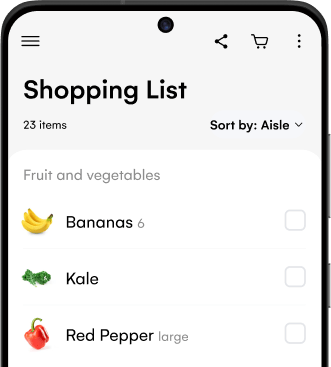Estimated reading time: 16 minutes
Bananas, which belong to the botanical family Musaceae, are well-loved and familiar fruits enjoyed worldwide. They have a captivating origin and a wealth of nutritional benefits. The different types of bananas originate from tropical regions and people cultivate them in countries with warm climates.
Nutritionally, bananas are a rich source of essential vitamins and minerals. They’ve also developed somewhat of a reputation for being an excellent source of potassium, a vital mineral for maintaining heart health and regulating blood pressure. That’s why you always see tennis players munching them on the court!
Plan meals together! Share this plan with your family

They also contain natural occurring sugar, which is a good addition to a healthy balanced diet. Additionally, bananas provide a good amount of vitamin C, vitamin B6, and dietary fiber, which aids in digestion and promotes a healthy gut. They’re the perfect breakfast food and are great for thickening smoothies or adding bulk to fruit salads.
From their humble beginnings in tropical regions to their widespread popularity today, bananas have come a long way to feature as a staple in many diets. They’re versatile, healthy, and delicious – plus, they’re naturally portable and easy to pack into lunchboxes or road trip snacks.
Banana Types from Across the World
You might think bananas are pretty standard – yellow, curved, and all the same. But actually, there are loads of different types and varieties. Ranging from the well-known classics to the charming (dare we say, even cute?) small bananas, read on for a comprehensive guide which covers the A-Z of various types of bananas.
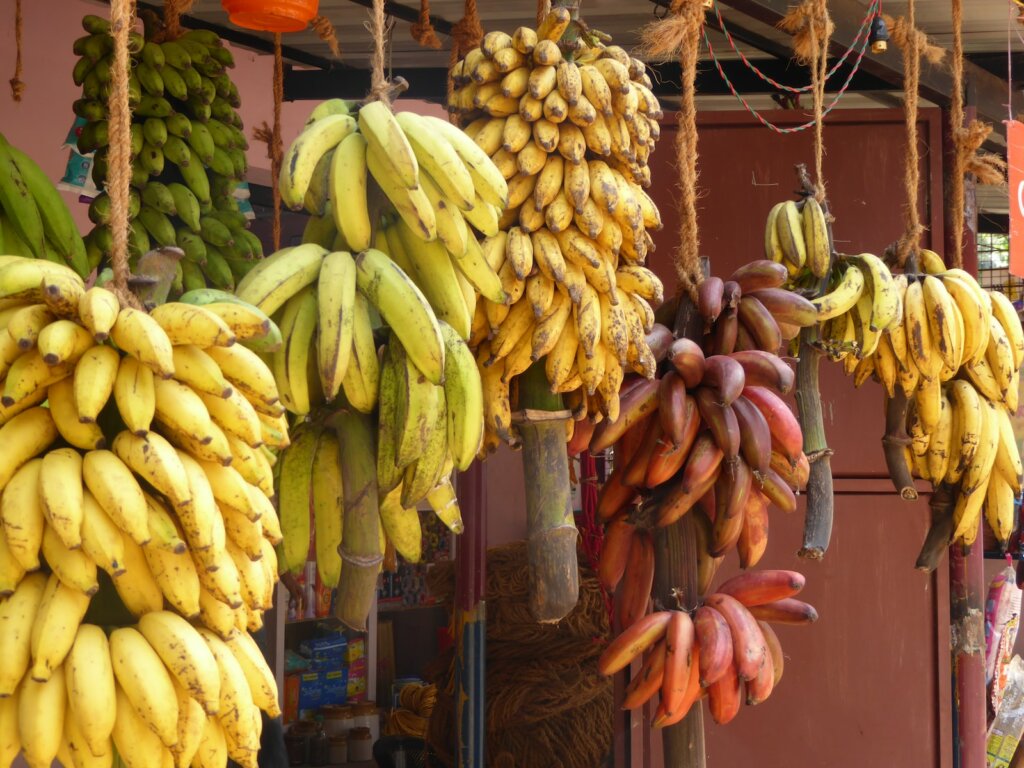
Table of Contents
- Types of Bananas
- Apple Banana
- Abyssinian Banana
- Burro Banana
- Blue Java Banana
- Cavendish Banana
- East African Highland Banana
- Ducasse Banana
- Fe’i Banana
- Gros Michel Banana
- Giant Highland Banana
- Embul Banana
- Hua Moa Banana
- Iholena Banana
- Jamaican Banana
- Kluai Khai Banana
- Kandarian Banana
- Lady Finger Banana
- Lakatan Banana
- Mysore Banana
- Mongee Banana
- Nanjangud Banana
- Orinoco Banana
- Plantains
- Raja Puri Banana
- Rasthali Banana
- Red Banana
- Saba Banana
- Señorita Banana
- Tanduk Banana
- FAQs
Types of Bananas
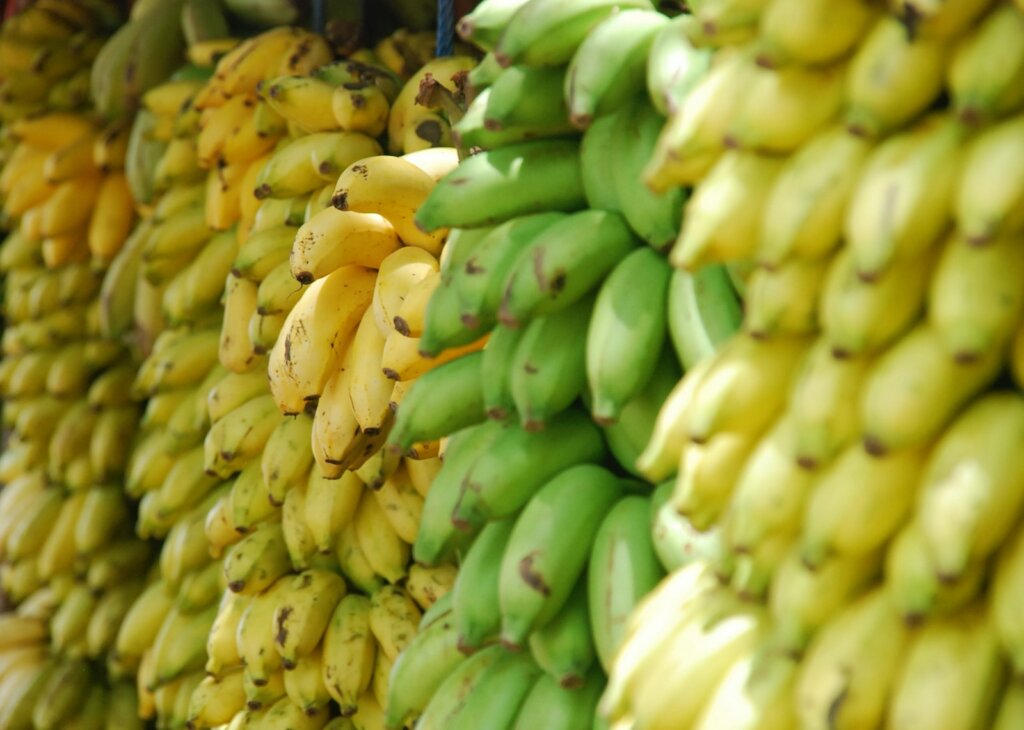
Apple Banana
Originating in tropical regions, Apple Bananas taste exactly how they sound! They are available worldwide and are known under different names such as Latundan, Silk banana, Pisang raja sereh, Manzana banana. These compact, golden-hued fruits have a distinctive combination of apple-like tanginess and the familiar sweetness of bananas. It’s natural fusion cuisine!
Abyssinian Banana
Originating in Ethiopia, the Abyssinian banana, also known as Ensete ventricosum, is a seriously pretty fruit. With its striking red and green hues, this banana adds unique visual appeal – and you know what they say: you eat with your eyes first.
It’s also called pseudo-banana, false banana and wild banana. Aside from culinary uses, it’s also popular with gardeners thanks to the huge, vibrant red leaves.
Burro Banana
Originating in Central America, the Burro banana, often referred to as the “chunky banana,” has a stubby, vibrant yellow exterior. They’re almost slightly square shaped, hence the nickname. When ripe, they also have brown spots or netting – but don’t be fooled, it’s just the exterior and doesn’t impact the taste at all!
It has a mild but slightly tangy flavor. You can eat it raw, of course, but it’s also really delicious when it’s cooked.
Blue Java Banana
The Blue Java banana is also known as “Kolb Blue” or “Ice Cream Blue.” When this type of banana is fully ripe, its flesh becomes creamy and has a texture similar to that of ice cream. If you’re a ‘nice cream’ fan and love the texture of frozen banana, the Blue Java might be your new favorite fruit!
This unique banana variety originates from Southeast Asia, specifically from regions with tropical climates. It has a slightly vanilla taste, which is amazing with the creamy texture!
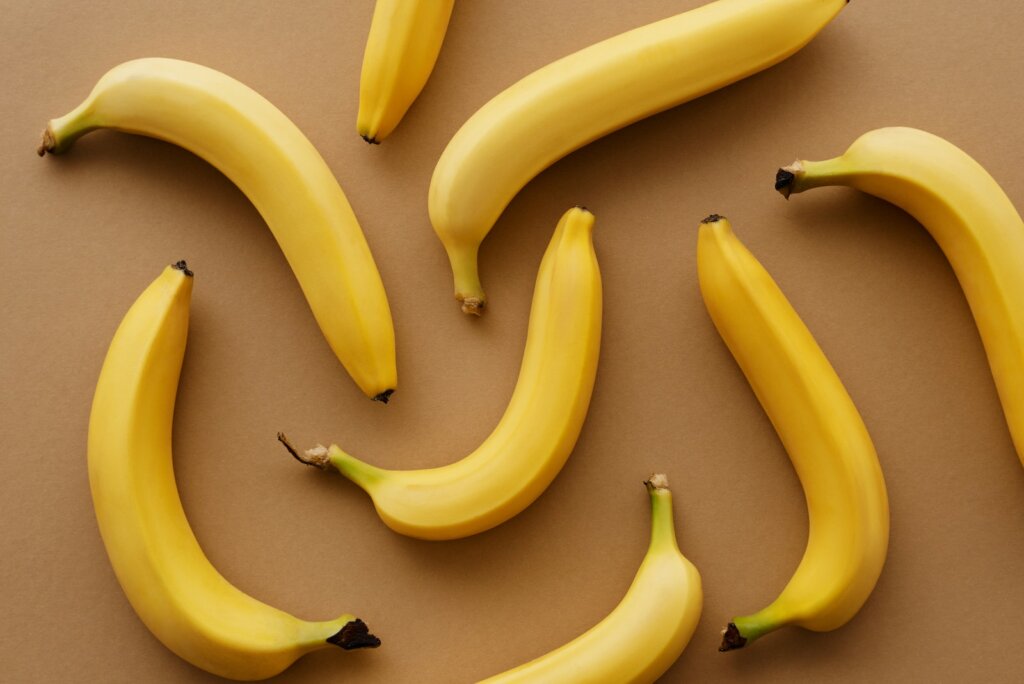
Cavendish Banana
The widely recognized and beloved Cavendish Banana is the most common banana in the world. Most likely, they’re the ones you pick up on your regular grocery shop or blend into your smoothies in the morning. Though they’re available everywhere these days, the Cavendish Banana originated in Southeast Asia.
East African Highland Banana
The East African Highland Banana is a prominent banana variety. This banana cultivar plays a crucial role in the dietary landscape of East Africa.
Known for its vibrant green appearance, this banana boasts a starchy texture and slightly tangy flavor. It’s a staple in regional cuisine, used in a variety of dishes like Matooke – considered a national dish in both Uganda and Rwanda.
Ducasse Banana
The Ducasse Banana comes from Southeast Asia, and is also known as a ‘sugar banana.’ They’re small and are considered a dwarf variety. It has greenish-yellow skin and creamy flesh, offering a sweet taste and smooth texture. This banana is versatile for snacking or cooking, adding a tasty and fragrant twist to dishes.
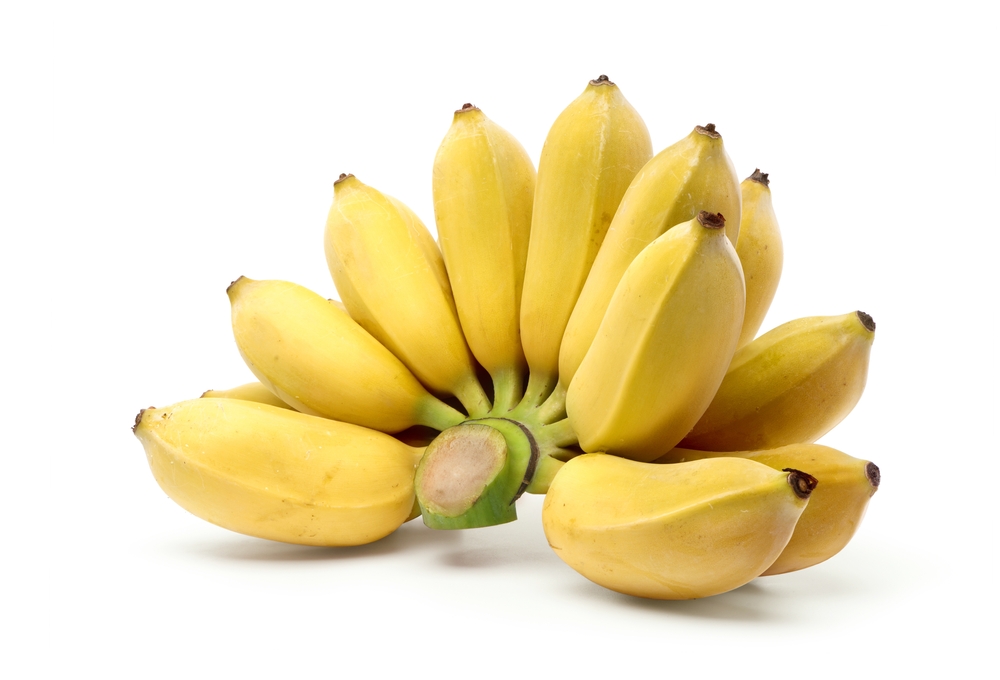
Fe’i Banana
The Fe’i Banana comes from the Pacific Islands and is known for its unique qualities. It has a long shape and vibrant colors that make it visually appealing. People love its rich, sweet taste and firm texture, enjoying it in different dishes. Because it’s important in traditional island cooking, its cultural significance makes it even more special.
Gros Michel Banana
The Gros Michel Banana originates from the Caribbean coast of Central America and is known for its strong taste and smooth texture. It used to be famous worldwide, but it decreased in popularity due to Panama disease. Still, it’s an important part of banana history, showing how banana farming and trade have changed.
Giant Highland Banana
The Giant Highland Banana, also known as “Pisang Kepok,” originates from the highlands of Southeast Asia, particularly Indonesia. It thrives in the elevated regions of countries like Indonesia, Malaysia, and other neighboring areas with similar climatic conditions. The highland environment plays a crucial role in shaping the unique characteristics and flavors of this banana variety.
Embul Banana
Originating in Sri Lanka, the Embul Banana is a noteworthy banana variety. It’s really unusual to look at, with its distinctive curved shape and vibrant yellow-orange peel. Locals enjoy the Embul banana for its mildly sweet flavor and soft texture, using it both as a snack and as an ingredient in various dishes like banana pudding and banana fritters.
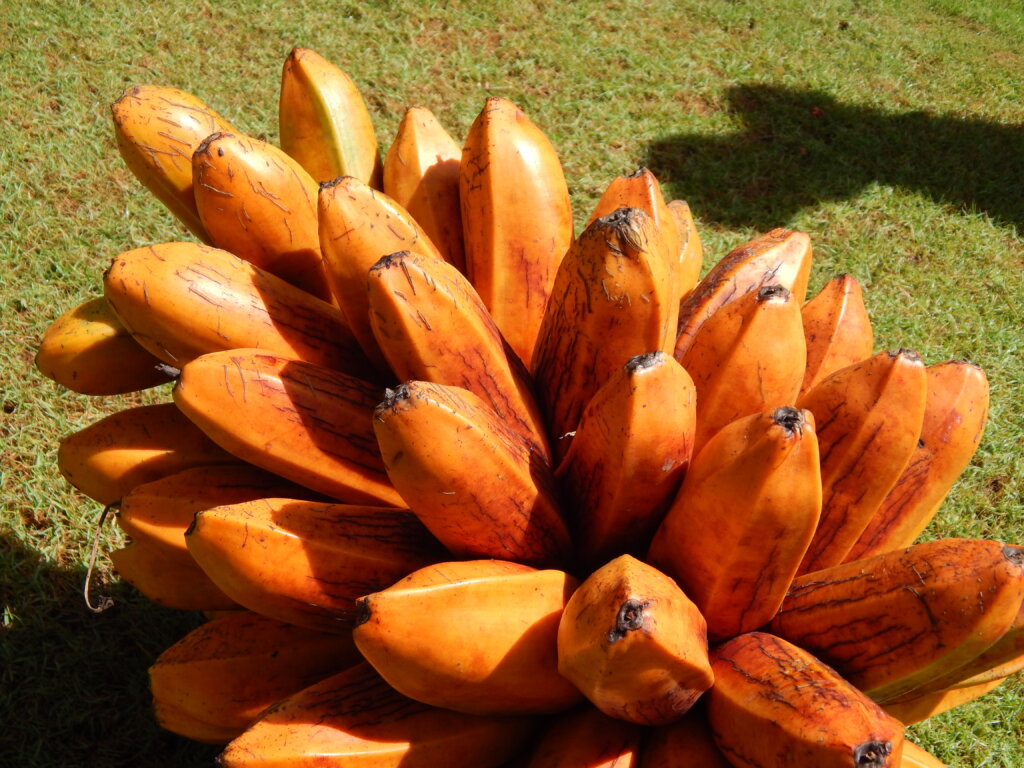
Hua Moa Banana
The Hua Moa Banana, which comes from the Pacific Islands, is a unique banana variety. It is unusually big, often reaching up to four inches in diameter! The plants can reach up to 14 feet tall. It has a particularly creamy texture and a mild, sweet flavor. It’s a favorite because you can eat it raw or cook with it, in the same way you’d cook plantain.
Iholena Banana
The Iholena Banana originates from Hawaii and stands out with its red and yellow peel. It’s often cooked, and can even be used as a substitute for potatoes. Iholena Bananas turn yellow before the fruit is ripe, rather than once it is ripe. Plus, instead of the usual curved or crescent shape, the fruit is more oblong
Jamaican Banana
The Jamaican banana, often called “Jamaican Plantain,” is a well-known and useful banana variety. It is a common ingredient in Caribbean cooking and is distinguished by its bigger size and higher level of starchiness than standard bananas. Like the Iholena Banana, it can be used in place of starches like potatoes.
The Jamaican Banana, which has its roots in tropical settings, is a culinary favorite. Why? Well, you can eat them both ripe or cooked, so at different stages of maturity. Fried plantains or banana fritters are popular dishes to make with this variety.
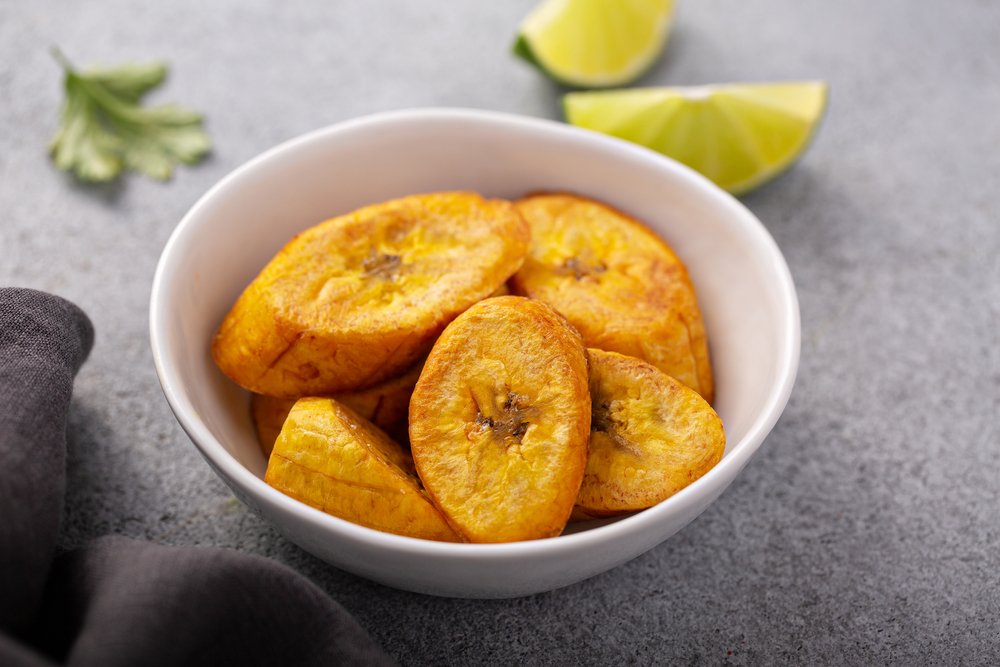
Kluai Khai Banana
Originating in Thailand, the Kluai Khai banana is small in size and has thin skin. True to it’s tropical roots, it’s a great fruit to snack on thanks to a sweet taste and fragrant scent. You can eat it fresh, or you can cook it in light syrups. Because it’s sweet and delicate-tasting, it’s also a popular choice when it comes to dried fruits, cakes, candies, and other dessert-type recipes.
Kandarian Banana
The Kandarian Banana tree is also known as the ‘Giant African Banana Tree.’ Funnily enough though, it finds its roots in Sri Lanka. The tree itself is tall, growing up to 30 feet. The fruit is thin-skinned, more stubby or oblong shaped. They start off tangy when they’re young, but mature into quite a sweet taste. Because they’re so resistant to disease, they’re easy to grow and the trees yield a lot of fruit – which can be eaten both raw and cooked.
Lady Finger Banana
Originating in Southeast Asia, the Lady Finger Banana is also known “small banana” or “baby banana. As you might imagine, it’s distinct mainly for it’s small size and slender shape. The Lady Finger Banana is sweeter than a regular banana and are straighter in shape too. They’re amazing for fruit salads because they don’t go brown once they’ve been cut.
Lakatan Banana
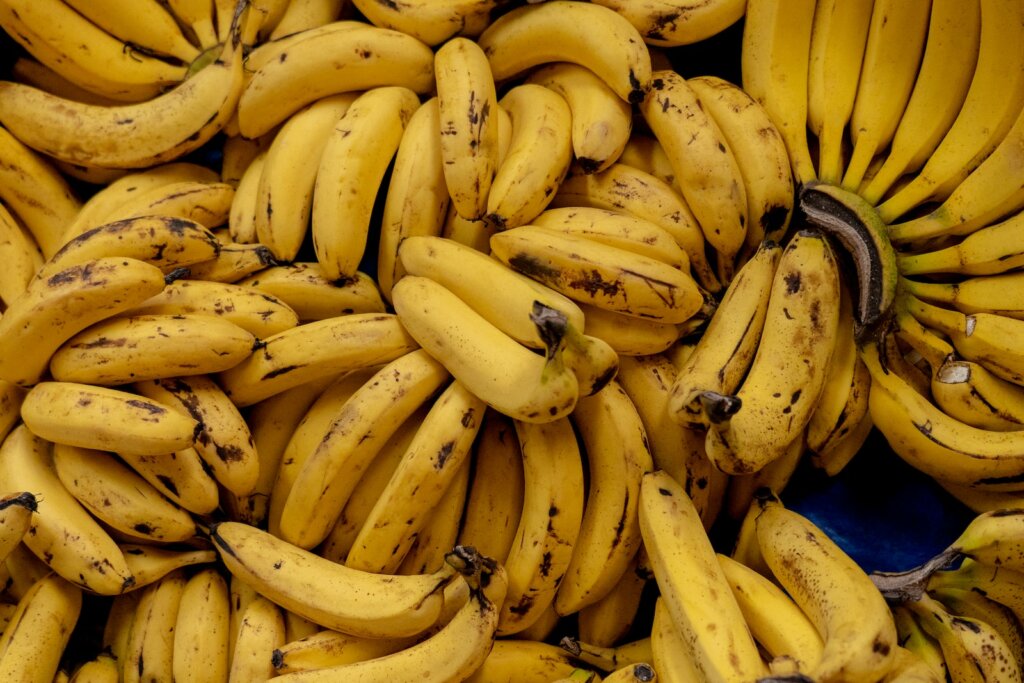
The Lakatan banana is a popular variety of dessert banana in the Philippines. It is known for its vibrant yellow peel and subtly tangy flavor. Lakatan is versatile for both snacking and culinary uses and it is appreciated because it’s easily available. They’re the most popular dessert banana in the Philippines, preferred over varieties like Cavendish and Latundan. They also have high B-carotene levels, which is typically associated with carrots and sweet potatoes.
Mysore Banana
Originating in India, the Mysore Banana is a popular variety.They’re sometimes called berry bananas, because they’re small and sweet. Also referred to as the “Mysore Rasbale” or “Pisang Ceylon” in Southeast Asia, it features a vibrant yellow peel and firm texture. Though it’s technically classified as a dessert banana, it’s actually suitable for both snacking and cooking. It’s a staple in Indian cuisine and they’re often used in banana buns.
Mongee Banana
The Mongee Banana, originating in Japan, is well known by foodie trivia fans. It’s grown at sub-zero temperatures, which is unusual enough. But it also has a very thin skin and is grown without any pesticides. The result is that you can eat the peel too. They also have a sweeter taste and stickier texture than regular bananas. A must-try if you visit Japan!
Dive into our content and find culinary inspiration

Nanjangud Banana
The Nanjangud Banana, which comes from India, is known for its special taste and texture. People often call it the “Rasabale.” It has a strong flavor and smells great, but people also love the texture – which they say is similar to butter. This banana is different from regular bananas like Cavendish because it’s both sweet and a bit sour, which makes it a great choice for eating and cooking.
The Nanjangud Banana is considered a “triploid” banana variety? This means it has three sets of chromosomes, which is more than the usual two sets in most banana types.
Orinoco Banana
The Orinoco Banana, originating in South America, is a distinctive banana variety valued for its versatility. Also known as “Pisang Awak,” it has a blend of both sweet and tangy flavors. It’s fairly starchy, which gives it quite a firm texture – but when it’s fully ripe, it’s softer to eat.
Like many other varieties on this list, Orinoco Banana is often used to make traditional banana fritters in some parts of South America.
Plantains
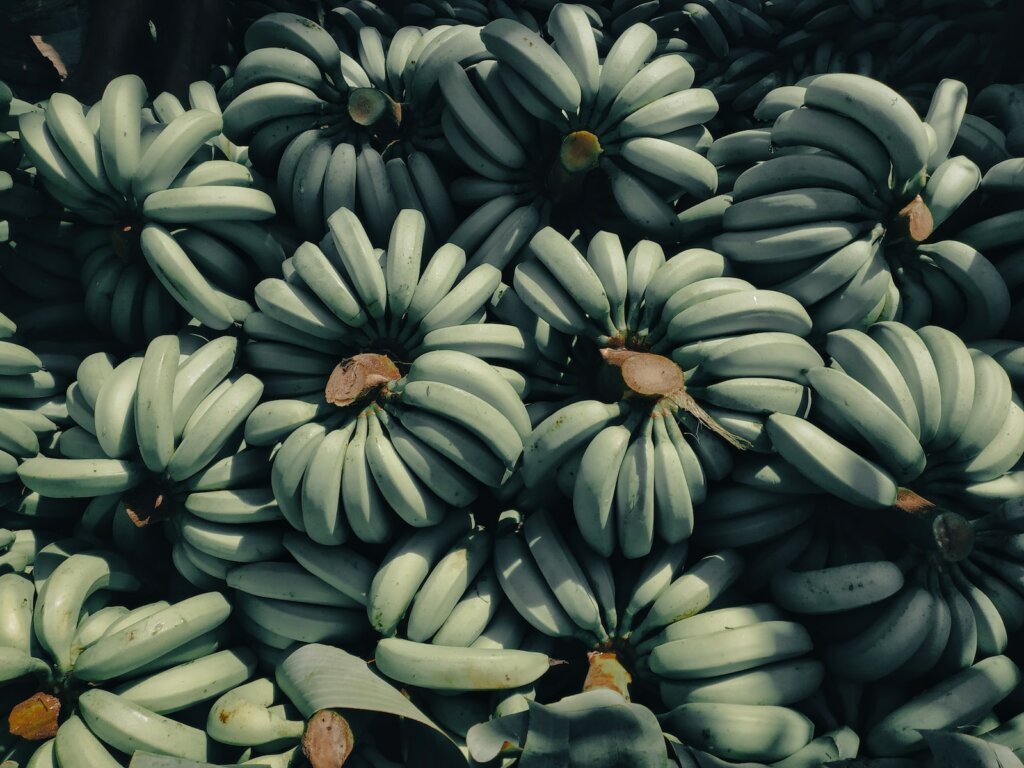
Plantains are starchy banana varieties, which are widely consumed around the world. These bananas are distinct for their larger size and versatility and are a dietary staple in various cuisines.
Due to their starch content, people usually cook plantains instead of eating them raw. You can do this in a few ways, but frying and boiling are both popular. With origins in tropical climates like Jamaica, plantains play a significant role in the culinary traditions of many cultures.
Raja Puri Banana
The Raja Puri Banana comes from India and is loved for its unique flavor – it’s sweet with a hint of tart raspberry taste. Imagine that mix of sweetness and a little bit of tanginess! People enjoy eating it raw, and they also use it for making desserts too.
The Raja Puri Banana plant survives well in colder conditions and the plants stay small. This means they’re often grown by people who have their own gardens or small farms.
Rasthali Banana
The Rasthali Banana, another type from India, stands out for its medium size and distinctive flavor profile. Renowned for its mildly sweet taste and firm texture, the Rasthali Banana is popular for both snacking and culinary applications. Its origin in the tropical landscapes of India adds to its appeal, making it a cherished component of local cuisine.
The Rasthali Banana, originating in India, is a notable type of banana. It’s known for being light and small but tasting sweet. It also has a creamy texture. So much so that some people even call it the “Silk Banana” because of how smooth it feels when you eat it. This banana is usually small and has a thin peel that’s easy to peel off. The Rasthali Banana is a great choice for homemade ice cream because of the taste and texture.
Red Banana
The Red Banana is a unique kind of banana that stands out because of its deep reddish-purple skin. This banana comes from warm places like East Africa, South America, and the UAE. They’re sweeter than normal bananas and usually have a longer shelf life too. The catch is that they’re much more expensive.
The red color of the skin is because of all the good stuff inside! Bananas this color contain more beta carotene and vitamin C than yellow bananas. They also contains potassium and iron. All those vitamins and minerals can be good for your health! In some cultures, the Red Banana is considered to be a symbol of good luck and prosperity, making it even more special.
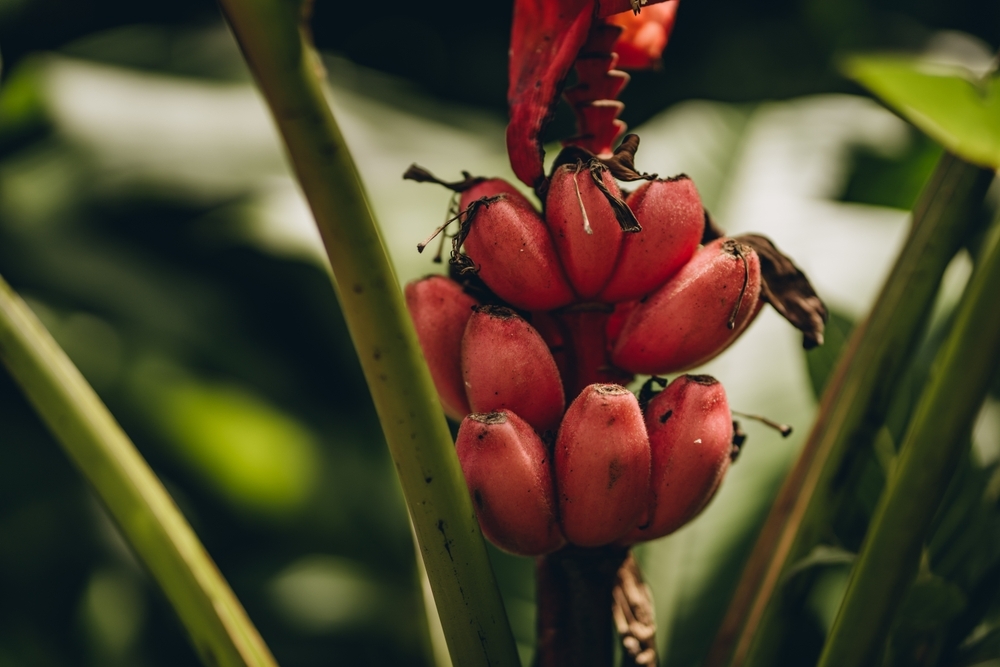
Saba Banana
Also originating in the Philippines, the Saba Banana is a versatile and one of the most widely used types of banana. It’s not usually eaten as a fruit or raw. Instead, it’s more like a potato in starch content and usage. It’s typically cooked, like frying or boiling it, and can be used in sweet or savory dishes.
The Saba Banana is often used to make a traditional Filipino delicacy called “turon,” where the banana is wrapped in a spring roll wrapper, sweetened, and then fried until golden and caramelized.
Señorita Banana
The Señorita Banana comes from the Philippines and is a special and popular type of banana. It’s a small banana variety and, like many of the varieties on this list, is known for being very sweet. They’re one of the shortest banana plants, and only reach around 8 feet tall. Because they’re not resistant to the cold, you don’t usually find them in big grocery stores – instead, you’ll pick them up at Filippino farmers markets or in rural areas.
In the Philippines it is known as ‘Monkoy’, ‘Sarot-sut’, ‘Cariños’ or ‘Cariñosa’, ‘Arnibal’ or ‘Inarnibal.’ And in some regions, it’s called the ’40 day banana’ which refers to how long it takes between flowering and fruit-bearing.
Tanduk Banana
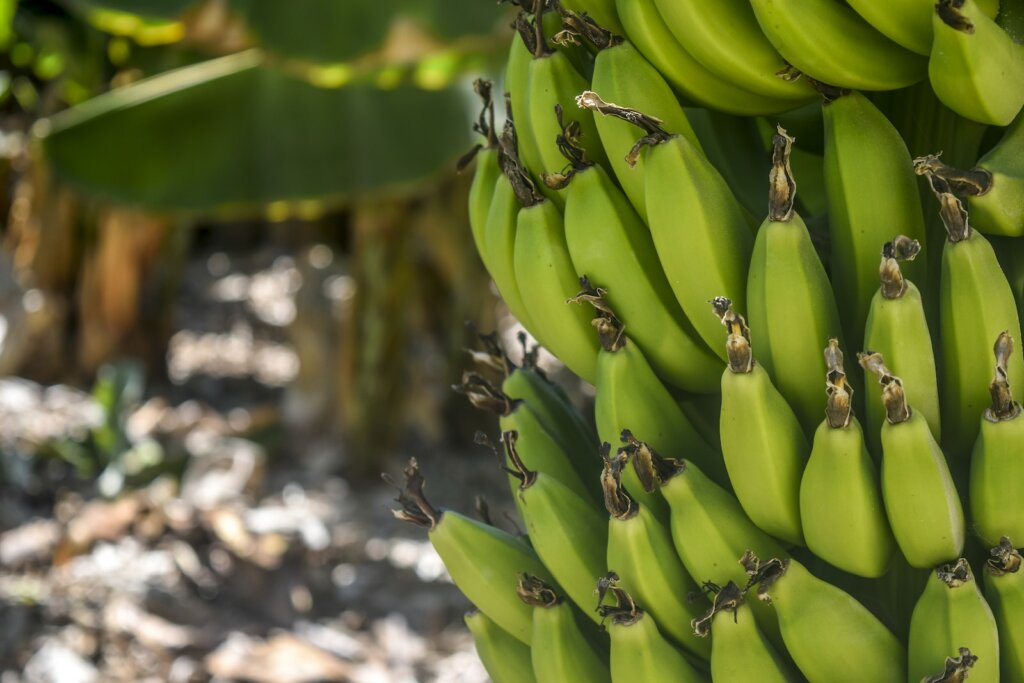
The Tanduk Banana, commonly referred to as the “Horn Banana,” is a rare and aesthetically striking cultivar that is native to Southeast Asia. It gets its name because “Tanduk” means “horn” in Malay, and this banana is long and curved, similar to the shape of a horn.
The Tanduk Banana, originating from Southeast Asia, is a fascinating banana type with a distinct look. The taste of the Tanduk Banana is unique too. It’s sweet with a hint of honey flavor, making it stand out from other bananas. People enjoy eating it when it’s ripe, and it’s also used in cooking. It’s particularly well suited for making banana chips, either fried or baked.
FAQs
There are numerous different types of bananas with estimates ranging from around 300 to over 1,000 varieties. These types of bananas belong to the same species, Musa sapientum. These unique banana varieties differ in sizes, colors, flavors, and textures. The most commonly known and consumed type of banana around the globe is the Cavendish banana.
The rarest banana is said to be the “Blue Java” banana, also known as the “Ice Cream” banana. This unique banana variety is notable for its blue-green color when unripe and its sweet, creamy texture and flavor when ripe, reminiscent of vanilla ice cream.
While both Plantains and Saba are considered types of cooking bananas, they are not the same variety. Plantains have a starchy, neutral flavor and versatile applications—from savory dishes when green to sweet preparations as they ripen. In contrast, Saba bananas are sweeter and creamier in texture than plantains.
When determining the readiness of bananas for cooking, check their color and texture. Green bananas possess a starchy quality, making them suitable for dishes such as banana chips. As they transition to yellow with hints of green, they become perfect for banana recipes that seek a balance between starchiness and sweetness. When their color transforms to nearly all black or dark, they reach their peak sweetness and softness, making them an excellent choice for desserts like banana fritters.
Absolutely! Bananas can add a unique and delicious twist to savory dishes. Their natural sweetness and creamy texture can complement various savory flavors. The mild sweetness of bananas can balance out spiciness or acidity in dishes, creating a harmonious flavor profile. Try adding sliced or mashed bananas to curries, stir-fries, sandwiches, or salads for a delightful contrast.
Be sure to check out our other lists with useful info, great tips and recipe ideas:
